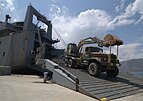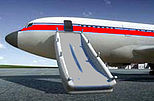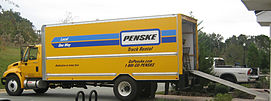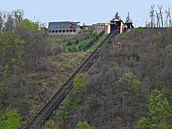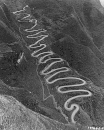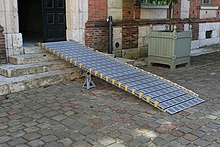
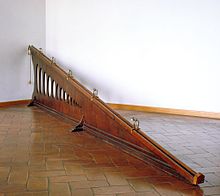
An inclined plane, also known as a ramp, is a flat supporting surface tilted at an angle from the vertical direction, with one end higher than the other, used as an aid for raising or lowering a load.[1][2][3] The inclined plane is one of the six classical simple machines defined by Renaissance scientists. Inclined planes are used to move heavy loads over vertical obstacles. Examples vary from a ramp used to load goods into a truck, to a person walking up a pedestrian ramp, to an automobile or railroad train climbing a grade.[3]
Moving an object up an inclined plane requires less force than lifting it straight up, at a cost of an increase in the distance moved.[4] The mechanical advantage of an inclined plane, the factor by which the force is reduced, is equal to the ratio of the length of the sloped surface to the height it spans. Owing to conservation of energy, the same amount of mechanical energy (work) is required to lift a given object by a given vertical distance, disregarding losses from friction, but the inclined plane allows the same work to be done with a smaller force exerted over a greater distance.[5][6]
The angle of friction,[7] also sometimes called the angle of repose,[8] is the maximum angle at which a load can rest motionless on an inclined plane due to friction without sliding down. This angle is equal to the arctangent of the coefficient of static friction μs between the surfaces.[8]
Two other simple machines are often considered to be derived from the inclined plane.[9] The wedge can be considered a moving inclined plane or two inclined planes connected at the base.[5] The screw consists of a narrow inclined plane wrapped around a cylinder.[5]
The term may also refer to a specific implementation; a straight ramp cut into a steep hillside for transporting goods up and down the hill. This may include cars on rails or pulled up by a cable system; a funicular or cable railway, such as the Johnstown Inclined Plane.
Uses
[edit]Inclined planes are widely used in the form of loading ramps to load and unload goods on trucks, ships and planes.[3] Wheelchair ramps are used to allow people in wheelchairs to get over vertical obstacles without exceeding their strength. Escalators and slanted conveyor belts are also forms of an inclined plane.[6]In a funicular or cable railway a railroad car is pulled up a steep inclined plane using cables. Inclined planes also allow heavy fragile objects, including humans, to be safely lowered down a vertical distance by using the normal force of the plane to reduce the gravitational force. Aircraft evacuation slides allow people to rapidly and safely reach the ground from the height of a passenger airliner.
Other inclined planes are built into permanent structures. Roads for vehicles and railroads have inclined planes in the form of gradual slopes, ramps, and causeways to allow vehicles to surmount vertical obstacles such as hills without losing traction on the road surface.[3] Similarly, pedestrian paths and sidewalks have gentle ramps to limit their slope, to ensure that pedestrians can keep traction.[1][4] Inclined planes are also used as entertainment for people to slide down in a controlled way, in playground slides, water slides, ski slopes and skateboard parks.
History
[edit]| Stevin's proof |

As pointed out by Dijksterhuis,[13] Stevin's argument is not completely tight. The forces exerted by the hanging part of the chain need not be symmetrical because the hanging part need not retain its shape when let go. Even if the chain is released with a zero angular momentum, motion including oscillations is possible unless the chain is initially in its equilibrium configuration, a supposition which would make the argument circular. |
Inclined planes have been used by people since prehistoric times to move heavy objects.[14][15] The sloping roads and causeways built by ancient civilizations such as the Romans are examples of early inclined planes that have survived, and show that they understood the value of this device for moving things uphill. The heavy stones used in ancient stone structures such as Stonehenge[16] are believed to have been moved and set in place using inclined planes made of earth,[17] although it is hard to find evidence of such temporary building ramps. The Egyptian pyramids were constructed using inclined planes,[18][19][20] Siege ramps enabled ancient armies to surmount fortress walls. The ancient Greeks constructed a paved ramp 6 km (3.7 miles) long, the Diolkos, to drag ships overland across the Isthmus of Corinth.[4]
However the inclined plane was the last of the six classic simple machines to be recognised as a machine. This is probably because it is a passive and motionless device (the load is the moving part),[21] and also because it is found in nature in the form of slopes and hills. Although they understood its use in lifting heavy objects, the ancient Greek philosophers who defined the other five simple machines did not include the inclined plane as a machine.[22] This view persisted among a few later scientists; as late as 1826 Karl von Langsdorf wrote that an inclined plane "...is no more a machine than is the slope of a mountain".[21] The problem of calculating the force required to push a weight up an inclined plane (its mechanical advantage) was attempted by Greek philosophers Heron of Alexandria (c. 10 - 60 CE) and Pappus of Alexandria (c. 290 - 350 CE), but their solutions were incorrect.[23][24][25]
It was not until the Renaissance that the inclined plane was solved mathematically and classed with the other simple machines. The first correct analysis of the inclined plane appeared in the work of 13th century author Jordanus de Nemore,[26][27] however his solution was apparently not communicated to other philosophers of the time.[24] Girolamo Cardano (1570) proposed the incorrect solution that the input force is proportional to the angle of the plane.[10] Then at the end of the 16th century, three correct solutions were published within ten years, by Michael Varro (1584), Simon Stevin (1586), and Galileo Galilei (1592).[24] Although it was not the first, the derivation of Flemish engineer Simon Stevin[25] is the most well-known, because of its originality and use of a string of beads (see box).[12][26] In 1600, Italian scientist Galileo Galilei included the inclined plane in his analysis of simple machines in Le Meccaniche ("On Mechanics"), showing its underlying similarity to the other machines as a force amplifier.[28]
The first elementary rules of sliding friction on an inclined plane were discovered by Leonardo da Vinci (1452-1519), but remained unpublished in his notebooks.[29] They were rediscovered by Guillaume Amontons (1699) and were further developed by Charles-Augustin de Coulomb (1785).[29] Leonhard Euler (1750) showed that the tangent of the angle of repose on an inclined plane is equal to the coefficient of friction.[30]
Terminology
[edit]Slope
[edit]The mechanical advantage of an inclined plane depends on its slope, meaning its gradient or steepness. The smaller the slope, the larger the mechanical advantage, and the smaller the force needed to raise a given weight. A plane's slope s is equal to the difference in height between its two ends, or "rise", divided by its horizontal length, or "run".[31] It can also be expressed by the angle the plane makes with the horizontal, .

Mechanical advantage
[edit]The mechanical advantage of a simple machine as defined as the ratio of the output force exerted on the load to the input force applied.The inclined plane the output load force is just the gravitational force of the load object on the plane, its weight . The input force is the force exerted on the object, parallel to the plane, to move it up the plane. The mechanical advantage is
The of an ideal inclined plane without friction is sometimes called ideal mechanical advantage while the MA when friction is included is called the actual mechanical advantage .[32]
Frictionless inclined plane
[edit]
If there is no friction between the object being moved and the plane, the device is called an ideal inclined plane. This condition might be approached if the object is rolling like a barrel, or supported on wheels or casters. Due to conservation of energy, for a frictionless inclined plane the work done on the load lifting it, , is equal to the work done by the input force, [33][34][35]
Work is defined as the force multiplied by the displacement an object moves. The work done on the load is equal to its weight multiplied by the vertical displacement it rises, which is the "rise" of the inclined plane
The input work is equal to the force on the object times the diagonal length of the inclined plane.
Substituting these values into the conservation of energy equation above and rearranging
To express the mechanical advantage by the angle of the plane,[34] it can be seen from the diagram (above) that
So
So the mechanical advantage of a frictionless inclined plane is equal to the reciprocal of the sine of the slope angle. The input force from this equation is the force needed to hold the load motionless on the inclined plane, or push it up at a constant velocity. If the input force is greater than this, the load will accelerate up the plane. If the force is less, it will accelerate down the plane.
Inclined plane with friction
[edit]Where there is friction between the plane and the load, as for example with a heavy box being slid up a ramp, some of the work applied by the input force is dissipated as heat by friction, , so less work is done on the load. Due to conservation of energy, the sum of the output work and the frictional energy losses is equal to the input work
Therefore, more input force is required, and the mechanical advantage is lower, than if friction were not present. With friction, the load will only move if the net force parallel to the surface is greater than the frictional force opposing it.[8][36][37] The maximum friction force is given by
where is the normal force between the load and the plane, directed normal to the surface, and is the coefficient of static friction between the two surfaces, which varies with the material. When no input force is applied, if the inclination angle of the plane is less than some maximum value the component of gravitational force parallel to the plane will be too small to overcome friction, and the load will remain motionless. This angle is called the angle of repose and depends on the composition of the surfaces, but is independent of the load weight. It is shown below that the tangent of the angle of repose is equal to
With friction, there is always some range of input force for which the load is stationary, neither sliding up or down the plane, whereas with a frictionless inclined plane there is only one particular value of input force for which the load is stationary.
Analysis
[edit]
A load resting on an inclined plane, when considered as a free body has three forces acting on it:[8][36][37]
- The applied force, exerted on the load to move it, which acts parallel to the inclined plane.
- The weight of the load, , which acts vertically downwards
- The force of the plane on the load. This can be resolved into two components:
- The normal force of the inclined plane on the load, supporting it. This is directed perpendicular (normal) to the surface.
- The frictional force, of the plane on the load acts parallel to the surface, and is always in a direction opposite to the motion of the object. It is equal to the normal force multiplied by the coefficient of static friction μ between the two surfaces.
Using Newton's second law of motion the load will be stationary or in steady motion if the sum of the forces on it is zero. Since the direction of the frictional force is opposite for the case of uphill and downhill motion, these two cases must be considered separately:
- Uphill motion: The total force on the load is toward the uphill side, so the frictional force is directed down the plane, opposing the input force.
|
Derivation of mechanical advantage for uphill motion The equilibrium equations for forces parallel and perpendicular to the plane are
|
- The mechanical advantage is
- where . This is the condition for impending motion up the inclined plane. If the applied force Fi is greater than given by this equation, the load will move up the plane.
- Downhill motion: The total force on the load is toward the downhill side, so the frictional force is directed up the plane.
|
Derivation of mechanical advantage for downhill motion The equilibrium equations are
|
- The mechanical advantage is
- This is the condition for impending motion down the plane; if the applied force Fi is less than given in this equation, the load will slide down the plane. There are three cases:
- : The mechanical advantage is negative. In the absence of applied force the load will remain motionless, and requires some negative (downhill) applied force to slide down.
- : The 'angle of repose'. The mechanical advantage is infinite. With no applied force, load will not slide, but the slightest negative (downhill) force will cause it to slide.
- : The mechanical advantage is positive. In the absence of applied force the load will slide down the plane, and requires some positive (uphill) force to hold it motionless
Mechanical advantage using power
[edit]
The mechanical advantage of an inclined plane is the ratio of the weight of the load on the ramp to the force required to pull it up the ramp. If energy is not dissipated or stored in the movement of the load, then this mechanical advantage can be computed from the dimensions of the ramp.
In order to show this, let the position r of a rail car on along the ramp with an angle, θ, above the horizontal be given by
where R is the distance along the ramp. The velocity of the car up the ramp is now
Because there are no losses, the power used by force F to move the load up the ramp equals the power out, which is the vertical lift of the weight W of the load.
The input power pulling the car up the ramp is given by
and the power out is
Equate the power in to the power out to obtain the mechanical advantage as
The mechanical advantage of an inclined plane can also be calculated from the ratio of length of the ramp L to its height H, because the sine of the angle of the ramp is given by
therefore,

Example: If the height of a ramp is H = 1 meter and its length is L = 5 meters, then the mechanical advantage is
which means that a 20 lb force will lift a 100 lb load.
The Liverpool Minard inclined plane has the dimensions 1804 meters by 37.50 meters, which provides a mechanical advantage of
so a 100 lb tension force on the cable will lift a 4810 lb load. The grade of this incline is 2%, which means the angle θ is small enough that sin θ≈tan θ.
See also
[edit]References
[edit]- ^ a b Cole, Matthew (2005). Explore science, 2nd Ed. Pearson Education. p. 178. ISBN 978-981-06-2002-8.
- ^ Merriam-Webster's collegiate dictionary, 11th Ed. Merriam-Webster. 2003. pp. 629. ISBN 978-0-87779-809-5.
inclined plane definition dictionary.
- ^ a b c d "The Inclined Plane". Math and science activity center. Edinformatics. 1999. Retrieved March 11, 2012.
- ^ a b c Silverman, Buffy (2009). Simple Machines: Forces in Action, 4th Ed. USA: Heinemann-Raintree Classroom. p. 7. ISBN 978-1-4329-2317-4.
- ^ a b c Ortleb, Edward P.; Richard Cadice (1993). Machines and Work. Lorenz Educational Press. pp. iv. ISBN 978-1-55863-060-4.
- ^ a b Reilly, Travis (November 24, 2011). "Lesson 04:Slide Right on By Using an Inclined Plane". Teach Engineering. College of Engineering, Univ. of Colorado at Boulder. Archived from the original on May 8, 2012. Retrieved September 8, 2012.
- ^ Scott, John S. (1993). Dictionary of Civil Engineering. Chapman & Hill. p. 14. ISBN 978-0-412-98421-1.
angle of friction [mech.] in the study of bodies sliding on plane surfaces, the angle between the perpendicular to the surface and the resultant force (between the body and the surface) when the body begins to slide. angle of repose [s.m.] for any given granular material the steepest angle to the horizontal at which a heaped surface will stand in stated conditions.
- ^ a b c d Ambekar, A. G. (2007). Mechanism and Machine Theory. PHI Learning. p. 446. ISBN 978-81-203-3134-1.
Angle of repose is the limiting angle of inclination of a plane when a body, placed on the inclined plane, just starts sliding down the plane.
- ^ Rosen, Joe; Lisa Quinn Gothard (2009). Encyclopedia of Physical Science, Volume 1. Infobase Publishing. p. 375. ISBN 978-0-8160-7011-4.
- ^ a b c Koetsier, Teun (2010). "Simon Stevin and the rise of Archimedean mechanics in the Renaissance". The Genius of Archimedes – 23 Centuries of Influence on Mathematics, Science and Engineering: Proceedings of an International Conference Held at Syracuse, Italy, June 8–10, 2010. Springer. pp. 94–99. ISBN 978-90-481-9090-4.
- ^ Devreese, Jozef T.; Guido Vanden Berghe (2008). 'Magic is no magic': The wonderful world of Simon Stevin. WIT Press. pp. 136–139. ISBN 978-1-84564-391-1.
- ^ a b Feynman, Richard P.; Robert B. Leighton; Matthew Sands (1963). The Feynman Lectures on Physics, Vol. I. USA: California Inst. of Technology. pp. 4.4–4.5. ISBN 978-0-465-02493-3.
- ^ E.J.Dijksterhuis: Simon Stevin 1943
- ^ Therese McGuire, Light on Sacred Stones, in Conn, Marie A.; Therese Benedict McGuire (2007). Not etched in stone: essays on ritual memory, soul, and society. University Press of America. p. 23. ISBN 978-0-7618-3702-2.
- ^ Dutch, Steven (1999). "Pre-Greek Accomplishments". Legacy of the Ancient World. Prof. Steve Dutch's page, Univ. of Wisconsin at Green Bay. Archived from the original on August 21, 2016. Retrieved March 13, 2012.
- ^ Moffett, Marian; Michael W. Fazio; Lawrence Wodehouse (2003). A world history of architecture. Laurence King Publishing. p. 9. ISBN 978-1-85669-371-4.
- ^ Peet, T. Eric (2006). Rough Stone Monuments and Their Builders. Echo Library. pp. 11–12. ISBN 978-1-4068-2203-8.
- ^ Thomas, Burke (2005). "Transport and the Inclined Plane". Construction of the Giza Pyramids. world-mysteries.com. Archived from the original on March 13, 2012. Retrieved March 10, 2012.
- ^ Isler, Martin (2001). Sticks, stones, and shadows: building the Egyptian pyramids. USA: University of Oklahoma Press. pp. 211–216. ISBN 978-0-8061-3342-3.
- ^ Sprague de Camp, L. (1990). The Ancient Engineers. USA: Barnes & Noble. p. 43. ISBN 978-0-88029-456-0.
- ^ a b Karl von Langsdorf (1826) Machinenkunde, quoted in Reuleaux, Franz (1876). The kinematics of machinery: Outlines of a theory of machines. MacMillan. pp. 604.
- ^ for example, the lists of simple machines left by Roman architect Vitruvius (c. 80 – 15 BCE) and Greek philosopher Heron of Alexandria (c. 10 – 70 CE) consist of the five classical simple machines, excluding the inclined plane. – Smith, William (1848). Dictionary of Greek and Roman antiquities. London: Walton and Maberly; John Murray. p. 722., Usher, Abbott Payson (1988). A History of Mechanical Inventions. USA: Courier Dover Publications. pp. 98, 120. ISBN 978-0-486-25593-4.
- ^ Heath, Thomas Little (1921). A History of Greek Mathematics, Vol. 2. UK: The Clarendon Press. pp. 349, 433–434.
- ^ a b c Egidio Festa and Sophie Roux, The enigma of the inclined plane in Laird, Walter Roy; Sophie Roux (2008). Mechanics and natural philosophy before the scientific revolution. USA: Springer. pp. 195–221. ISBN 978-1-4020-5966-7.
- ^ a b Meli, Domenico Bertoloni (2006). Thinking With Objects: The Transformation of Mechanics in the Seventeenth Century. JHU Press. pp. 35–39. ISBN 978-0-8018-8426-9.
- ^ a b Boyer, Carl B.; Uta C. Merzbach (2010). A History of Mathematics, 3rd Ed. John Wiley and Sons. ISBN 978-0-470-63056-3.
- ^ Usher, Abbott Payson (1988). A History of Mechanical Inventions. Courier Dover Publications. p. 106. ISBN 978-0-486-25593-4.
- ^ Machamer, Peter K. (1998). The Cambridge Companion to Galileo. London: Cambridge University Press. pp. 47–48. ISBN 978-0-521-58841-6.
- ^ a b Armstrong-Hélouvry, Brian (1991). Control of machines with friction. USA: Springer. p. 10. ISBN 978-0-7923-9133-3.
- ^ Meyer, Ernst (2002). Nanoscience: friction and rheology on the nanometer scale. World Scientific. p. 7. ISBN 978-981-238-062-3.
- ^ a b Handley, Brett; David M. Marshall; Craig Coon (2011). Principles of Engineering. Cengage Learning. pp. 71–73. ISBN 978-1-4354-2836-2.
- ^ Dennis, Johnnie T. (2003). The Complete Idiot's Guide to Physics. Penguin. pp. 116–117. ISBN 978-1-59257-081-2.
- ^ Nave, Carl R. (2010). "The Incline". Hyperphysics. Dept. of Physics and Astronomy, Georgia State Univ. Retrieved September 8, 2012.
- ^ a b Martin, Lori (2010). "Lab Mech14:The Inclined Plane - A Simple Machine" (PDF). Science in Motion. Westminster College. Retrieved September 8, 2012.
- ^ Pearson (2009). Physics class 10 - The IIT Foundation Series. New Delhi: Pearson Education India. p. 69. ISBN 978-81-317-2843-7.
- ^ a b Bansal, R.K (2005). Engineering Mechanics and Strength of Materials. Laxmi Publications. pp. 165–167. ISBN 978-81-7008-094-7.
- ^ a b This derives slightly more general equations which cover force applied at any angle: Gujral, I.S. (2008). Engineering Mechanics. Firewall Media. pp. 275–277. ISBN 978-81-318-0295-3.

